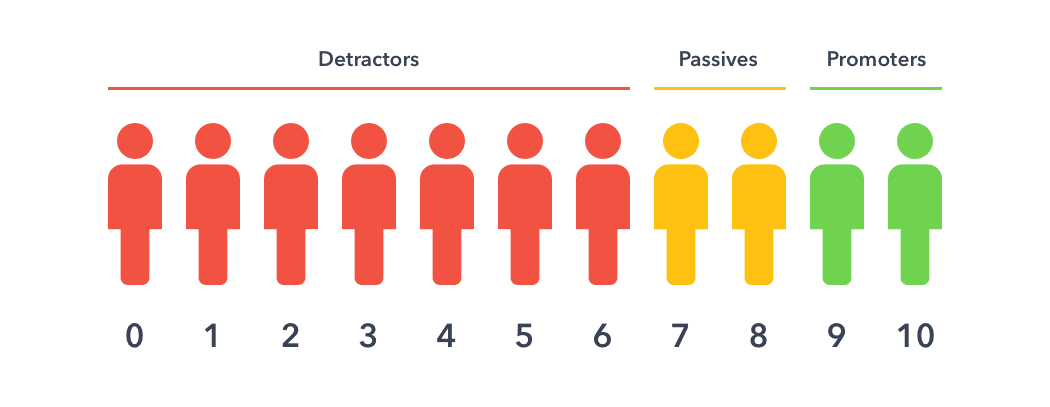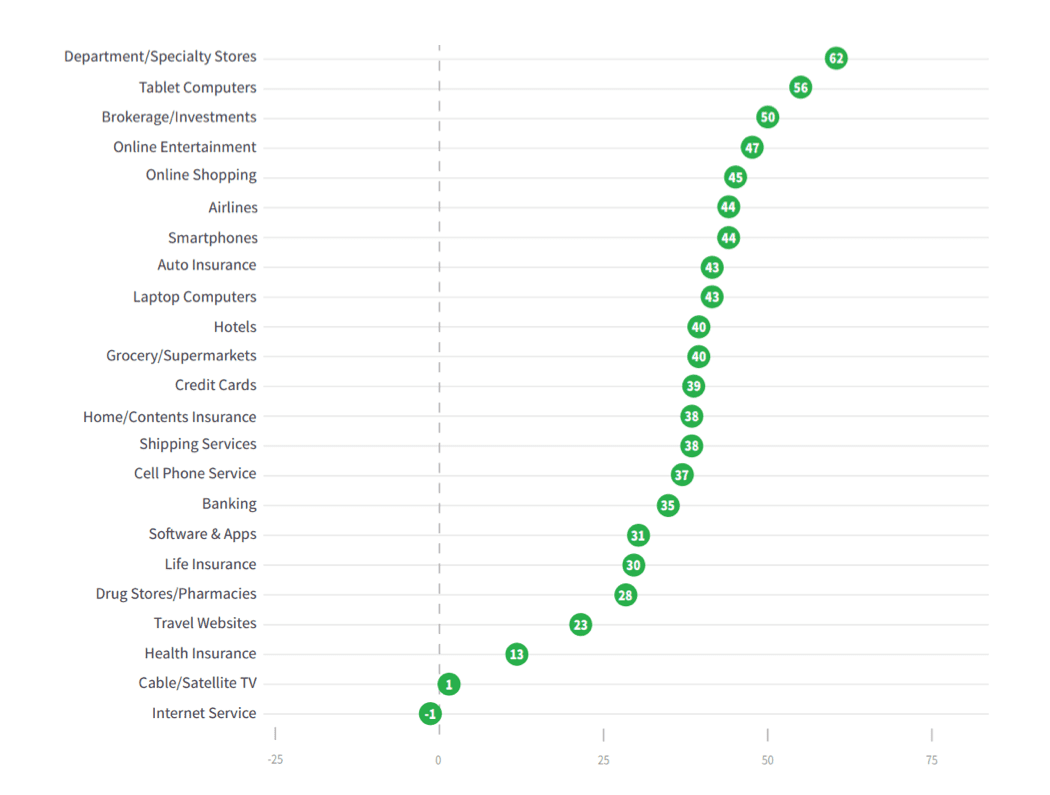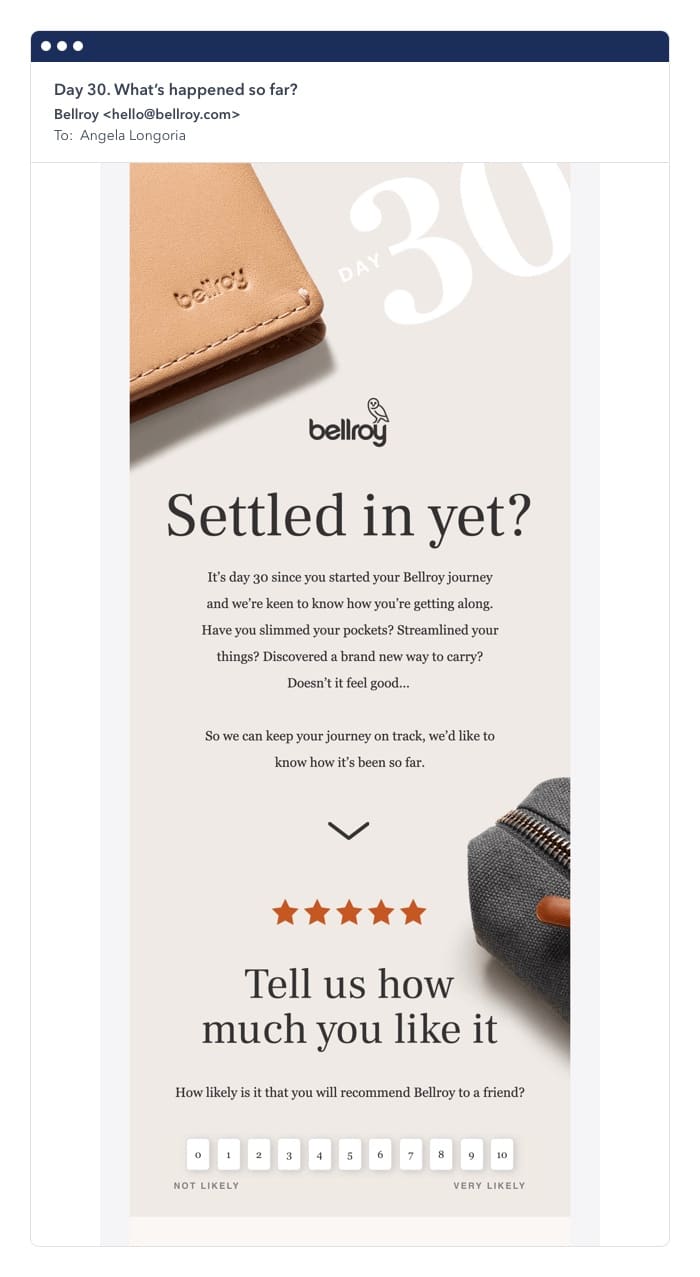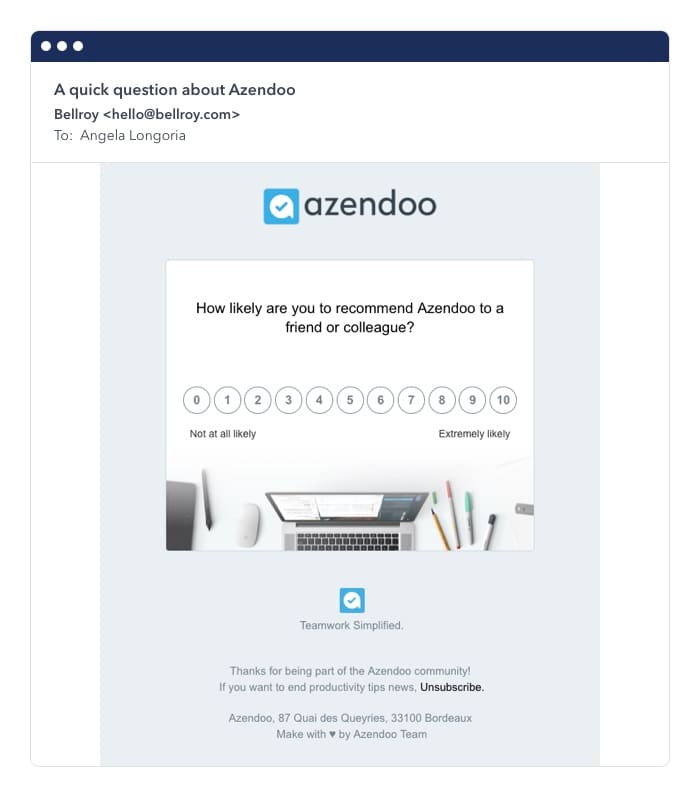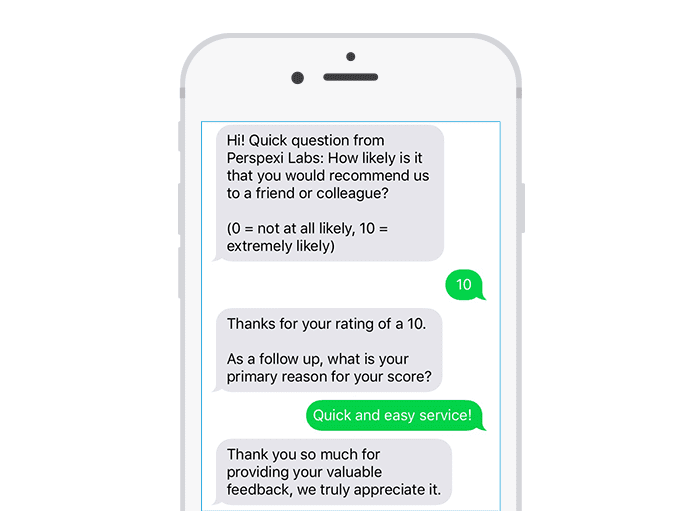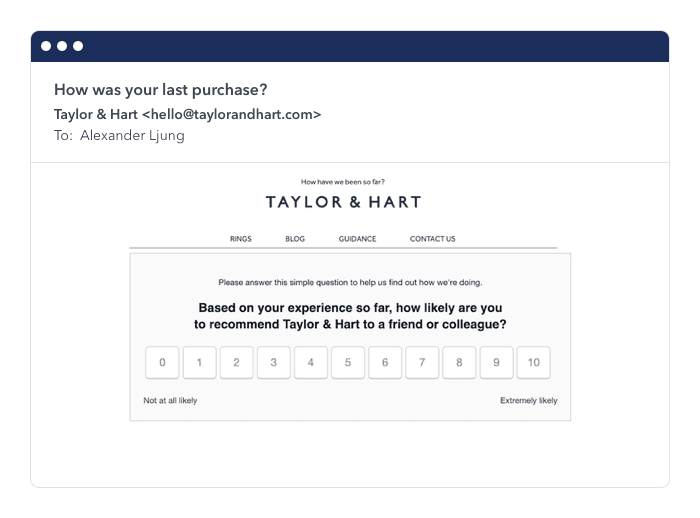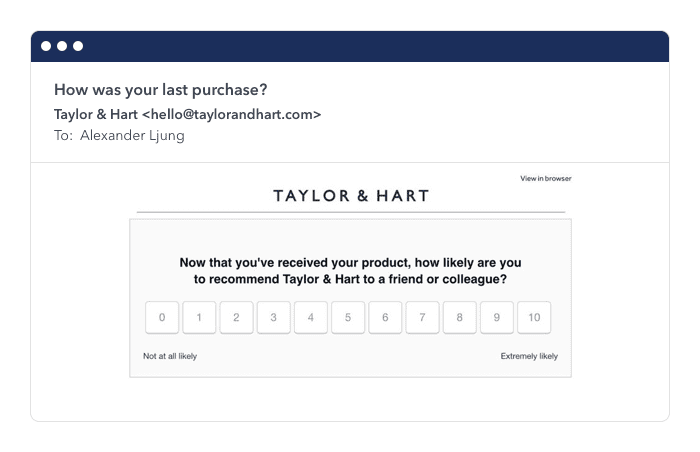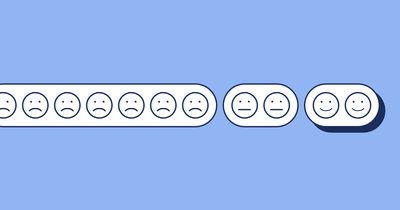
How to use NPS emails to improve the customer experience
-
Data ManagementUpdatedPosted:
On this page
How to use NPS emails to improve the customer experience
According to a Nielsen report, 92% of people trust recommendations from friends and family over any other type of advertising.
It’s a no brainer right?
We value the opinions of the people we trust, over marketing we’re exposed to.
But the value we place on the opinions of others extends even outside our social circle as 88% of people trust online reviews as much as personal recommendations.
It’s good to ensure your customers are having great experiences, and root out the causes of dissatisfaction before bad word of mouth spreads.
The need to consistently improve the customer experience is why the Net Promoter Score (NPS) is one of the most important metrics for organizations to monitor.
What is NPS?
The Net Promoter Score, also known as NPS, is a simple way of gauging a customer’s loyalty to your brand by asking one question:
“How likely are you to recommend our company to a friend or colleague?”
The customer can then choose an answer on a scale of 0 (highly unlikely) to 10 (highly likely):
These customers are then segmented based on their responses into one of three groups:
- Promoters (9-10): These are your brand’s most loyal customers. They’ve made multiple purchases and love your product. They’re also advocates, so they tend to bring in more customers by word of mouth.
- Passives (7-8): These customers are satisfied with their experience but they aren’t loyal to your brand. With time, some of them will either become promoters or detractors.
- Detractors (0-6): These customers are very unhappy with your product or service. They’re at risk of churning and can prevent other customers from using your product by sharing their bad experiences with them.
Because your NPS is based entirely on customer sentiment, it correlates strongly with company growth.
Promoters, for instance, are more than five times likely to be repeat buyers, seven times as likely to forgive a mistake, and nine times as likely to try a new offering compared with detractors.
How to calculate your NPS
After you’ve surveyed your customers, your NPS is calculated by subtracting your percentage of detractors from your promoters:
NPS = detractors (%) – promoters (%)
For example, if 10% of your customers are detractors, 50% are passives, and 40% are promoters, then your NPS would be:
40% – 10% = 30
Your score can range from -100 to 100. And according to SurveyMonkey’s global benchmark data, the average score for most companies is 32, while the top 25 percent of brands have an NPS of 72 or higher.
But since NPS varies by industry, you should compare your score only to other companies within your space.
Here’s a diagram that shows the average scores across 23 industries:
Knowing industry benchmarks helps you set more realistic improvement targets for your NPS.
6 NPS emails best practices
1. Make sure you have the right sample size
When it comes to any statistical study, the size of your sample can make or break your test and NPS surveys are no different. If you don’t have a large enough sample size, then you can’t be sure of your survey’s accuracy.
This is because the number of surveyed people depends on the size of your current customer base, and how accurate you’d like the result to be.
If accuracy is paramount for you, then the larger the sample size needs to be.
Here’s a table from SurveyMonkey that shows how many customers you’d have to survey in respect to your audience size at different confidence intervals:
| Population | +3% | +5% | +10% |
|---|---|---|---|
| 500 | 345 | 220 | 80 |
| 1,000 | 525 | 285 | 90 |
| 3,000 | 810 | 350 | 100 |
| 5,000 | 910 | 370 | 100 |
| 10,000 | 1,000 | 385 | 100 |
| 100,000 | 1,100 | 400 | 100 |
| 1,000,000 | 1,100 | 400 | 100 |
| 10,000,000 | 1,100 | 400 | 100 |
You can see that, in order to get lower error margins, you have to survey a greater percentage of your audience.
While surveying all of your customers might seem like a more straightforward path, you have to keep in mind that NPS captures sentiments relating to the customer experience. If your survey includes a lot of new customers, your NPS will be inaccurate.
Rather than sending your NPS survey to every customer at once, you should instead use their current lifecycle stage and behavior to determine when a survey should be sent.
Accessory brand Bellroy, for example, sends this email after the first 30 days of purchase:
That way they can ensure that the customer has had enough time to use the product and can give true feedback.
Remember, because of sample size you’ll need to have enough responses so your NPS stays accurate.
SurveyMonkey has a useful sample size calculator that can help you determine how many survey respondents you need for whatever confidence level you want.
2. Use a distribution channel that works for you
When it comes to distributing your survey, the channel you use ultimately depends on the nature of your business and audience.
Most brands choose email because they already have their customer’s email addresses.
Distributing surveys this way is easy to set up, effective, and has a wide reach.
Like this email from Azendoo:
You can also distribute your survey through your app, website, and even through text messages like in this example:
Conducting your surveys through an app or website lets you get more responses from active users and you’ll be able to choose exactly when a user sees your survey.
That way you can collect NPS feedback as soon as an important customer milestone is reached.
It’s worth noting that both email and embedded surveys complement each other. You can use email to reach users who aren’t too active, and use embedded (in-app or website) surveys to get feedback from your active users.
Whatever channel you use to distribute your survey, make sure to keep your message concise and to always thank respondents for their time.
3. NPS data should be used company wide
NPS data shouldn’t be something that only customer support or high-level employees have access to in an organization.
After all, NPS can act as a roadmap informing everything from marketing, product, and sales teams. As you gather more feedback from your promoters and detractors, the feedback from respondents will add valuable insight.
For instance:
- Product teams can use this feedback to prioritize features and reduce friction points associated with using a product.
- Marketing can use the insights they’ve learned from promoters to create better campaigns that emphasize value propositions customers care about.
- Sales can use this same data to identify who ideal customers are and the selling points that appeal to them.
- NPS data from detractors can even help customer support teams identify what customers have the most trouble with, and help dissatisfied users.
A great example of how NPS can be an instrument for improving company-wide initiatives is the case of Magoosh, an online test prep company.
Magoosh sends out an NPS survey after their students have completed their tests, so they can gauge how well their services prepared them for it.
When they noticed a drop in their score, they started looking into the cause. The Magoosh team discovered that the drop was caused by their algorithm, which told students to expect a higher score than they received in the actual test.
Thanks to NPS, Mangoosh changed their algorithm to better reflect expected test scores, and A/B tested it to see if lower scores would demoralize students.
It didn’t, and their NPS improved substantially after the algorithm change.
4. Pay attention to trends in your NPS data
Always look for trends in your NPS data as they may reveal unexpected insights. For example, you might find that people living in certain geographic locations or specific customer segments have lower NPS ratings than other customers.
If your NPS sample size is large enough, you might consider segmenting the data based on:
- Customer segment
- Customer location
- User role within the organization (for B2B products)
- Customer age/cohort (new, three months old, 12 months old, etc.)
- Customer size (how much they pay)
By looking at specific groups of customers, you might find that these customers are being underserved in some way.
For example, there might be a location-specific problem such as delayed shipping times.
Or there may be a cohort-specific problem such as sub-optimal onboarding. Or, you may discover that support is improperly trained to handle requests from certain customers.
Looking for trends and patterns in your NPS data could reveal opportunities for massive customer experience improvements.
5. Constantly monitor your NPS
Your NPS isn’t a static metric. It’s something that’ll constantly change as your business, industry, and customers change.
As your NPS is only as useful as it is accurate, it’s generally recommended that you survey your customers often.
What’s the ideal frequency when it comes to NPS surveys?
For most businesses, once a quarter is a good frequency to stick to, but the best way to determine your survey frequency is to consider your specific customers and their needs.
For example, Taylor & Hart, a London-based jeweler specializing in bespoke engagement rings sends two NPS email surveys to their customers. The NPS surveys capture feedback at two important customer milestones:
- When a customer places an order
- When the order is received
The first survey, known internally as the “service NPS,” comes an hour after an order is placed and measures how satisfied customers are after interacting with their consultants.
The customer receives the second product-related NPS survey 40 days after they make a purchase. This is because it takes about 22 days on average for a ring to be made and shipped.
The extra 18 days is there to account for any fluctuations caused by late deliveries or holidays, and also to give customers a chance to use the product.
Taylor & Hart’s focus on making NPS a core focus of their business has led to them having one of the highest scores in the industry.
Their score has consistently been over 80 for both the service and product NPS surveys.
To sum up…
The net promoter score (NPS) can teach you a lot about your audience and dramatically improve your customer experience.
We’ve covered a lot in this article, so here’s a summary of key points:
- Since NPS varies by industry, you need to look for benchmarks in your space to measure your progress against it.
- Remember that your score is only useful if it’s accurate, so get the right sample size and survey your customers frequently.
- To get honest feedback from your customers, you need to survey them only after they’ve had time to reflect on their experience.
- Email is a great channel for distributing your NPS surveys, but depending on the behavior of your customers – in-app, website and even text-based surveys can work just as well.
- Always look out for trends in your NPS data as they might signal opportunities for improvements.
- Most importantly, customer feedback once collected, has to be taken seriously and acted upon. This means it’s not just a customer support issue and has to involve stakeholders within the company.
Want to send more personalized mobile and email messages to your users?
Learn moreCustomer story

How Vero helps Plann cater to the needs of an agile startup that's scaling up quickly

